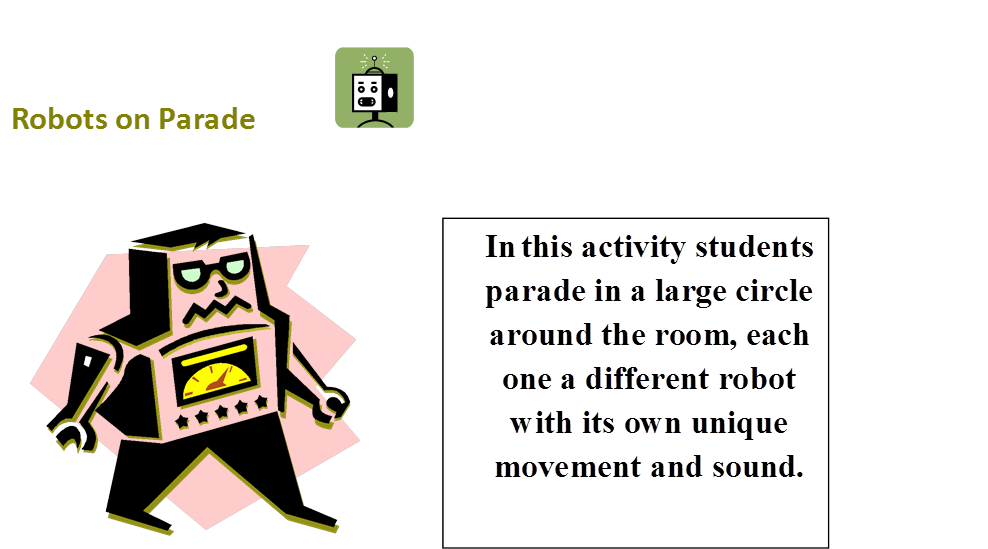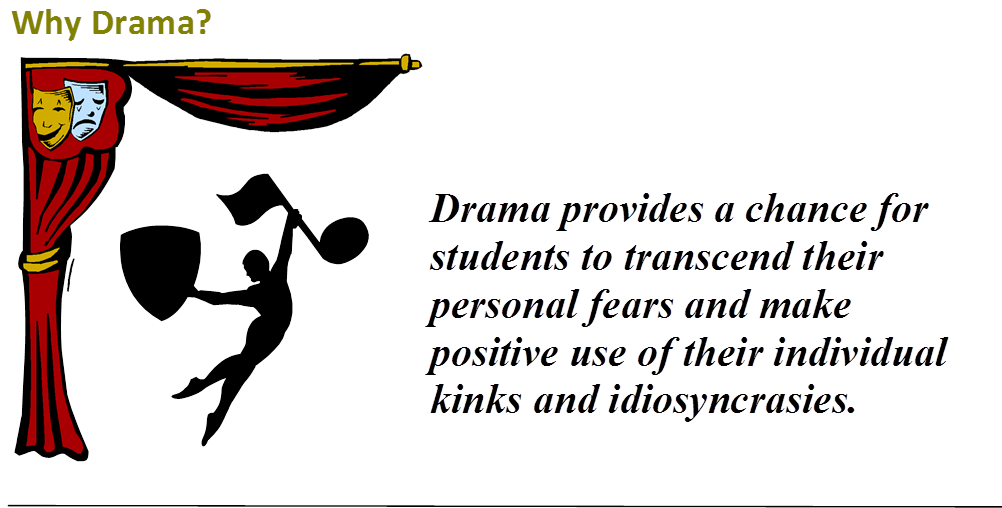Drama in the Classroom
written by Reggie Hart
1. Warm-up and Creative Exercises
2. Stage a Tickle-Trunk Skit
3. Staging a large Drama using groups of 10 – 12 or larger.
Warm-Up Exercises, Theater Games and Staging Small Skits
Some good starting points for using drama in the classroom are exercises, theater games and skits. After many repetitions of these short theater games and skits, students will be more confident that they can put on a big play.
Drama is a great help for shy students, helping them learn to work in a group and overcome their fears. Some students will want to organize and lead, and sometimes this is fine, but some students became too bossy. The teacher should always be on-hand to settle disputes and promote a team effort. On occasion, a student’s negative feelings will show itself in drama. This may produce a positive result in the long term. Drama is a safe way for people to work out anger, frustration and fears.
[Drama is a great help for shy students.]
![]()
Theater Games and Drama Exercises

The Do-Nothing Machine
This activity promotes harmony and imagination. Students work in groups of three and create a machine.
To make the machine: The first student goes to the middle of an empty space in the room and begins a simple, but repetitive movement such as bending the arm at the elbow, moving one leg, or bobbing the head. At the same time, the student makes a nonsense sound or something onomatopoetic such as bang, clank, bonk, buzz, crunch, growl, screech, squish, thud, thump, zing, zoom, crash, ka-ching, or any sound the student desires.
Then, each member of the group, one at a time will enter and do a different, yet harmonic, repetitive movement and sound. In other words the students work as a unit to create a unique, sometimes comical machine that does nothing: The Do-Nothing Machine.
1. Divide the class into groups of three and they can take turns being the audience.
2. The audience is as important as the actors.
3. Student A goes to the middle of an empty space and does a repetitive movement and sound.
4. Then Student B and Student C, one at a time, should join in, with each doing a repetitive sound and reoccurring movement.
5. Students should work closely together; interact, but not touch each other as they create the machine.
In addition to being creative,the activity is great physical exercise.It promotes teamworkas well as utilizingindividual strengths.There is no failure.Every student enjoys total freedom to act and interact in the activity.
This activity helps students to think visually and three-dimensionally and gets them using their bodies.The audience is always delighted. A variation is using animal sounds: sometimes called the “3 Headed Beast”.
![]()

Name that Face
Have the students sit in circles. One large circle if the area allows. If not, divide the students into groups of 4 – 6.
Have each student say their name three times.
1. In an angry voice.
2. In a confused voice.
3. In a sad voice.
The students should use facial expressions and tone of voice to indicate to the other students which emotion is being expressed. Other students call out the name of the emotion. At the end, the teacher tells the students that they have been acting!!!
______
Just say No!!!
This warm-up activity is similar to Name that Face, but done in groups of two.
A pair of students practice saying "please" and "no" in three different ways. They should feel free to play around with their voices and facial expressions. It is also helpful to be able to stand up and use full body movement: body language. After a few repetitions, the students exchange roles. Working with a partner helps introverted students overcome their shyness.
![]()

Tickle Trunk Skit
Bring in different objects -- hats, sunglasses, old kitchen utensils, discarded badminton rackets, car keys, an old camera, coats, gloves etc. Put the items into a cardboard box or a large, opaque plastic container.
1. The students fish around without looking and pick an item, or the teacher hands out the items.
2. The students then have 4-5 minutes to come up with a short skit using the items.
3. Every item has to have a meaning in the skit and obviously, each student has a part.
4. Groups of three or four can be working in different areas of the room simultaneously.
5. After a few minutes, each group goes to the front to perform their skit.
*Teacher can decide the skit order by lottery or ask for volunteers.
![]()

Robots on Parade -- In this activity students parade in a large circle around the room, each one a different robot with its own unique movement and sound. Variations include astronauts, monsters, fashion models, gangsters, or whatever the imagination leads you to.

Chill Out! - a relaxation exercise
Students place heads on desk to relax.
Turn down the lights and tell the students to think of themselves as relaxed as limp spaghetti. They should make up a peaceful place --lying on a floating raft or at the beach or on a soft patch of grass; somewhere they love to be.
Do this for exactly 3 minutes. Then the students share where they'd been and what they'd felt or imagined. Some may chose not to tell. It is a voluntary exercise.
![]()
![]()
Drama provides a chance for students to transcend their personal fears and sometimes make use of their diverse kinks and idiosyncrasies.
People love imitating other people and getting dressed up in costumes. There is nothing more fun than pretending. It helps us, young and old alike to cope with whatever comes along. Acting is therapeutic and so much fun!


Staging Large Dramas
Staging a large drama using groups of 10 – 12 or larger requires more time and practice. Props and scenery can be non-existent, simple or sometimes incredibly complicated and detailed. For this type of production the best results will come from older students in grades 4 – 6 or higher. Reading ability is essential. Additionally, it is advisable to have the students be familiar with the plot of the drama prior to encountering a script. The teacher can use various methods to introduce the story-line: reading a story-book, watching a video, using a Power-point presentation or even making it a homework assignment.
First things first
There are numerous decisions to make before beginning a large scale production:
1. What size of staging area can we use?
2. How many students will be involved?
3. What level of English skills do the students have? What grammar points might be practiced within the dialogue?
4. Should we write an original script or use one previously written? Should we adapt a folk tale or a local legend? Should we search the library or browse the internet for play scripts?
Once a script is chosen assemble the students and have them sit in a circle or around a table. Then have a mock-reading of the script involving as many students as possible. If the script is short read it a couple of times using different students. After that, decide on the various roles for the students. Some students will be actors and some will be involved with off-stage production.
Actors: Although the actors are the ones in the spotlight, they should be humble and follow the advice of the director. Try to avoid having the same students acting in every stage production. If time permits, auditions could be held for the lead roles.
It is a good idea for one of the students to take on the leadership role of ‘director’.

Off-Stage Production Crew
Student Director: It is a good idea for one of the students to take on the leadership role of ‘director’. The director leads all aspects of the practice; deciding the location of props, the positions of the actors, and the other large decisions involved with staging a large-scale production. The director envisions the play from the audience’s perspective.
Stage Manager: Assists the director by arranging backdrops and stage props and by managing the stage hands.
Stage Hands: Anyone can be a stage hand. Stage hands help move props, open and close curtains, help with costuming, lighting, sound and anything else required to make the play a smashing success.
![]()
Blocking
Stage Directions are given by the Director during the rehearsal. This is known as blocking. "Blocking" the show is very important. All the actors should be as visible as possible to the audience. Try to avoid having one actor standing directly in front of another. The actors should know the various motions on the stage and know how and when to enter and exit -- and where to be at all times on the stage. The actors are given directions that help the scene to progress and facilitate the movement of the play. The various movements of the actors help to convey whatever emotion/effect the Director is going for in that scene.
The diagram here explains the Director's instructions. On stage your viewpoint is reversed from that of the audience, and the director and actors and all involved in the production must learn to understand this viewpoint.
The script should have directions for the actors (enter stage right, exit stage left, stand downstage center, sit left center and so on). The director uses these blocking directions to aid the flow of the action and help all the actors to move harmoniously around the stage.
Another part of blocking is to position the actors so that, when they move, they have their backs to the audience as little as possible. Part of that idea dates back to pre-microphone days. Actors are heard better when they face the audience rather than when they have their heads facing the backdrop or the curtains. Plus, the human face is more expressive than the back of the head.
Finally, actors have to practice not looking at the audience or acknowledging their presence while playing to them, thus establishing an invisible Fourth Wall. This helps establish a suspension of disbelief, giving the audience a sense that they are witnessing reality and not simply watching an amateur production. Correct blocking assists in maintaining that Fourth Wall whose line the actors should not normally cross.
Of course there are many steps to take in a large-scale production. Teachers and students should work together to create a successful performance. The attention spent in the planning and practice stages are the most important. Remember to put the effort up front and reap the rewards later.
Improvs and Warmups
This is a small collection of improvisation games and warmup games that can be used to sharpen up your cast if you're a director, or to add energy and originality to your students' acting if you are an acting teacher. All can be done with no materials in any reasonably sized space. As well as being great practice in themselves, they are great for refocusing a group that has become scattered, or for waking up one that has become jaded.
None of these games are my own inventions, although I've made some modifications on some of them. I've written very few improvisation or warmup games for actors, largely because a.) There are already lots of good ones out there, including the ones below, and b.) In my current job I mostly work in creative drama, not theatre, so I don't really use formal acting games much. When I started this site I didn't intend to include any lessons unless I'd written them myself or received them from someone who had sent them in specifically. But I get lots of e-mail from folks requesting improvisation games and warmups for actors, so I've tried to collect together all the ones I could think of. I use all of these games either in my classes or in my rehearsal process. In most cases I don't know who invented these games, nor have I made any particular effort to find out. If you think you are the inventor of one of these games, and you don't want it on my site, let me know. (Although I don't know why anyone would mind.)
I will be adding games as they occur to me or as I learn new ones. Check back periodically.
________________________________________
Freeze and Justify
The Granddaddy of 'em all. Just about everyone who has ever had an acting class knows this one, so I'll be brief.
The group sits or stands around the acting space.
Two people enter the space and begin to improvise a scene, with dialogue and as much physical action as possible.
At any moment, anyone else in the group may shout, "FREEZE!"
The actors freeze instantly and exactly.
The person who stopped the scene taps one of the actors on the shoulder. The actor sits down and the new person takes his or her position exactly.
The new person must now initiate a new and DIFFERENT scene. The scene must flow naturally from the positions of the two bodies, and it is the new person's responsibility to communicate to his or her partner and to the audience what the new scene is about.
At any moment another person may shout, "FREEZE!" and it begins again.
Pointers
With some groups it is necessary to make a rule that no one may freeze a scene until the situation has been clearly established and both actors have contributed.
With groups of kids I sometimes have them take turns saying, "Freeze!" In other words, as a scene goes on, only one person is allowed to freeze it. Then when he does, the next person is allowed to freeze it, and so on.
If you have a reticent student, you can shout "Freeze!" for him and then coach him as necessary.
________________________________________
The Martha Game
I have no idea who Martha is or how this game got its name. Works best with a group of 8 - 12. With a larger group, divide them into two teams.
Group stands outside a designated performance space.
One person runs into the space, forms her body into a statue and announces what she is, as in "I'm a tree."
Instantly the next person runs on and forms something else in the same picture. "I'm a bench under the tree."
The next person further adds to the picture. "I'm a bum on the bench."
"I'm a dog peeing on the tree."
"I'm the newspaper the bum is sleeping under."
Etc., until the whole group is part of the picture.
Start again. And again. Etc.
Coach this to go very, very fast. There is no time to think--just go!
If there are two teams, they alternate.
Pointers
Fast, Fast, Fast!
Make sure a different person starts each picture.
Variations
After a while, you might say, "Okay. . .on a count of three this becomes a moving picture!"
Or even, "A moving, talking picture!"
________________________________________
What Are You Doing?
Lots of zany fun.
Group gets in a line at the edge of the playing space. The first person enters the space and begins to pantomime a simple activity--for example, brushing his teeth.
The second person runs on and says, "What are you doing?"
The first person may answer anything EXCEPT what he is actually doing. In our example he might say, "I'm washing the car."
The moment the second person hears the answer, she must begin to pantomime the mentioned activity.
The first person goes to the end of the line and the third person runs on and says, "What are you doing?"
Etc.
Pointers
The person acting MUST NOT STOP until he or she has answered the question. Side coach to make sure.
The new person MUST START IMMEDIATELY when the answer is heard.
The answer MUST NOT be what the person is doing, but, for convenience, it should also NOT be something that LOOKS LIKE what the person is actually doing.
Variations
After a while, add to the original formula, "I'm _________." It can become, "I'm _________ with a ________." Eventually it can become, "I'm _________ with a __________ while ___________." (For example, "I'm painting the barn with a codfish while snorkeling." It doesn't have to make sense.) The second person must begin to act as soon as she hears even PART of the answer. (In the example, we should see her painting the barn even before she hears that she's using a codfish. When she hears about the snorkeling she'll have to adjust.) Side coach to make sure they get all three details into their pantomiming.
You can play this as a tournament if you want. Two people bounce the question back and forth until one of them "fouls" by repeating himself, stopping the action before answering the question, not starting the acting in time, or answering the truth. A new challenger steps in, and so on until all but one person have been eliminated.
________________________________________
Everyone Who. . .
More of a warmup game than an improvisation game. A little like musical chairs.
Everyone sits in a circle. There should be one fewer chairs than people.
The person who is left in the middle ("IT") says something like, "Everyone wearing red." or, "Everyone who has a brother," or "Everyone who is left-handed." Any description that is likely to describe some and unlikely to describe all will do.
Everyone who fits the description must move to a different chair.
"IT" is also trying for a seat.
Usually a different person will be left standing, and become "IT."
In addition to being fast-paced and very physical (especially when played with highly competitive, creative adults), this game helps a cast to get to know each other, and it calls for strategy that depends in part on how well "IT" knows the others. Great fun.
________________________________________
Pinocchio
This is a really great way to start a rehearsal on a physical high. It is a physical warmup/stretching exercise with dramatic content to keep it focused. It is named after the wooden puppet. (Sometimes at Christmas I do this with my young students and call it The Nutcracker. I suppose Pygmalion would work too.) It consists basically of a narrative pantomime of the wooden puppet SLOWLY coming to life. What follows is approximately what I say. (This one I did create.)
Right now you're made completely of wood. Your arms and legs are carved from a single piece of wood. You can't move any part of yourself at all.
Now the magic spell has begun. It begins at the top of your head. The spell moves down slowly until your head down to your eyebrows is flesh and blood. Try and move your eyebrows.
The spell keeps moving down. Now you can move your eyes! All your life you've been staring straight ahead, and now you can look to the sides.
The spell gets to your ears and your nose. See if you can wiggle them.
The spell gets to your mouth. You can smile. It feels strange at first, and probably looks pretty strange too, but you grow more comfortable with it. Try some other facial expressions as well.
Slowly you discover that you can turn your head. Careful! You can look up and down carefully as well. Look! You have feet! This is the first time you were ever sure.
The spell reaches your shoulders. But remember, your arms and hands are still attached to your torso, since you are carved from a single piece of wood, so you can move ONLY your shoulders. Try some circles. Do you feel a tingle up and down your spine? That's the magic working.
The spell reaches your chest. You can puff it out like a soldier.
Your elbows can move now, but still not your hands. As the spell goes lower, see if you can pull your left hand away from your body. Ooofff! You did it.
Bring your hand up to your face and study it. See if you can move the fingers. Wow! You've never seen anything so beautiful!
See if you can get your right hand free as well. Does it move too?
The spell has reached your waist. Carefully bend forward, to the side. See if you bend backwards. See if you can make a circle.
The spell reaches your hips, but your knees are still locked together and your feet are still attached to your pedestal.
The spell gets to your knees. See if they bend!
Reach down and see if you can pull your left foot free. Ooofff! Point the toe. Flex the foot. Make little circles.
Now see if you can get your right foot free.
You're all real now! See how you can move. Careful at first--these are your first steps! Let's find all the ways our new bodies move!
________________________________________
Murder Mystery
This one's complicated, but it can be really fun for an advanced group. I don't do this with my elementary students, but when I get a chance to play it with the folks in the performing troupe to which I belong, I just love it. It's a little like a cross between the board game "Clue," the kids' game "Whisper Down the Lane," and the parlor game "Charades." Central to the game is the idea that there has been a murder, and the task is to discover Who was murdered, Where they were murdered, and How they were killed. (Think, "A noun is a person, place, or thing.") The order is important, as you will see.
The group divides into two teams. Team A leaves the room, and Team B brainstorms a person, place and thing. (For example, Shirley Temple, in Burger King, with a butter churn.)
The first person from Team A enters, and Team B tells her the three things.
The second person from Team A enters.
The first person must communicate all three items without speaking. The twist is that the second person can't speak either, so there is no way for the first person to be sure she has communicated successfully. The second person may indicate through sounds, humming or gestures that he does or does not understand--he may even try to "restate" an item in a different way to be sure he has it, but no language of any kind is permitted.
When the second person thinks he has all three items, the next person enters, and the message is passed on in the same way.
When the last person in Group A thinks she has figured out the three items, she announces her conclusion--which is almost never identical to the original information.
The teams switch roles and the process is repeated.
Pointers
It is a good idea to establish at least a little bit of "Charades Code" to start with. For example, holding up one, two, or three fingers can indicate which of the items--person, place or thing--is being performed at a given time. Usually the three items are enacted one at a time. It is not necessary to act out the actual crime. (In the example, you might hum "The Good Ship Lollipop" and mime curly hair for Shirley Temple, eat a pretend hamburger after indicating a crown for Burger King, and then mime churning butter. It is not necessary to mime clubbing poor Shirley with the churn--and in fact it will probably confuse the issue by making the "churn" look less like a churn.)
Music (hummed but not, of course, sung) can be extremely useful here. I once saw a person act "Tinkerbell" by three bars of the opening music from The Wonderful World of Disney and tapping an imaginary wand. The person receiving understood instantly. Commercial themes, television show themes, pop music--all are easily recognized and convey much.
If a group is good at the game, they will start deliberately choosing combinations of items that will be hard to guess, but at first a leader might want to veto items that are too obscure. (Of course, half the fun of the game is that people get off on the wrong track, and since half of the group is always "audience" they are able to watch as the train comes derailed.)
It is very difficult for players familiar with charades to understand that not only the "giver" but the "receiver" as well must not speak. Be sure to stress this. You cannot, as in charades, verbalize your guesses so as to help the actor know how he's doing.
________________________________________
Hitchhiker
This game combines improvisation with careful observation, and so makes a great rehearsal tool for serious improv performers who need to be able to see and imitate easily. Plus it's lots of fun.
Set up four chairs to resemble the front and back seats of a car.
The first three people get in the car, leaving the rear passenger-side seat empty.
The three people in the car invent a scenario to explain their traveling together, and mime driving along, improvising a conversation, etc.
The next person in line enters the scene as a hitchhiker. The hitchhiker must have a fairly clearly defined character.
The people in the car must stop to pick up the hitchhiker, but they improvise how politely they do it, etc., based on their characters.
Once the hitchhiker is in the car and a four-way conversation begun, everyone in the car begins to pick up the hitchhiker's personality and mannerisms. (For instance, if the hitchhiker is paranoid, soon everyone is paranoid. If the hitchhiker is drunk, soon everyone is drunk. If the hitchhiker is excessively cheerful, soon everyone is, etc.)
Once everyone has fully taken on the new personality, the driver leaves the scene and everyone moves over one seat, so that the front passenger becomes the driver, the driver's-side rear passenger becomes the front passenger, etc.
Repeat with a new hitchhiker, who has a different personality. (Until they have picked up the new person, the three in the car continue to play the first hitchhiker's personality.)
Pointers
If you feel the game has gone on long enough, just enter the scene yourself as a hitchhiker who is blind, or a small child, or something else guaranteed to cause a fatal accident once the driver catches it.
________________________________________
Look Up (Dude!)
I call this game "Dude!" but most people call it "Look Up" or some other less exciting name. It is an excellent focusing exercise, and is useful both for getting a cast to function as a unit and for evaluating how well an ensemble is working.
Stand in a circle. Everyone look at the floor.
When the leader calls out, "Look up!" everyone must look directly into the face of someone else in the circle.
Most people will find they are looking at someone who is not looking back at them, but a few people will probably find that they are staring directly into someone else's eyes.
When this happens, these two people are "out," and must exclaim to each other, "Dude!" as they leave the circle.
Continue in this fashion until only one (or, if there's an even number in the group, two) are left.
At first this won't take very long, but after a while a group will get to the point where they can go for a long time without anyone being knocked out. It takes a real psychic bond--essential also for real ensemble work.
Variations
If this is being used as a warmup and you don't want an elimination game (as I often don't) you can play so that any two who find themselves facing each other must shout, "Dude!" and change places as fast as possible.
Obviously the "Dude!" part is not required. I just think it makes it more fun.
Pointers
With young performers, watch carefully so that they don't "cheat." They may fall into a pattern, which will of course prevent anyone from going out, but it defeats the purpose of the game. Stress that patterns are not allowed, and enforce it. More mature actors should not need this push.
________________________________________
The Shakes
I learned this game from a colleague. I don't know where he learned it. It's lots of zany fun.
Everyone stands in a circle. One person begins to develop "the shakes" in one particular, localized part of his body. (For instance, his foot might begin to shake violently.) After the shakes are fully developed, that person "throws" the affliction across the circle to another person. Eye contact is important here, so that it is clear who is being "thrown" to. The new person "catches" the shakes in the same body part. Gradually the shakes move to a different body part. (For instance, the tremor might travel up the leg until it eventually comes to rest in a hand.) Once the affliction is firmly established in its new location, the victim "throws" it to another person, etc. Try not to repeat any body part exactly. (It may be necessary, of course, to repeat "foot," but maybe the shakes themselves are different, or it locates in a particular toe or something the second time.) Continue to play until everyone is running out of ideas.
Pointers
It is okay, and in fact encouraged, to get creative. I once had a whole group in hysterics when I "shook" my brain.
________________________________________
Mr. Hit
I learned this lesson from a colleague in an improv troupe. It is supposed to be a way of learning the names of a group, and it works, but it is also great (and exceedingly difficult) with a group whose names are already familiar to each other.
Stand in a circle. One person announces, "I am Mr. Hit!" Mr. Hit begins walking directly (but slowly, at first) towards another person in the circle, with his hands out in front of him like a zombie. If he touches (hits) the person, they are "out" and must leave the circle. The only way the intended victim can stop Mr. Hit is to call out the name of another person in the circle before any contact is made. No fair running away.
Once a name is called out, that person instantly becomes Mr. Hit and begins advancing on a victim. (He doesn't have to announce that he is Mr. Hit after the first time.) Again, the only way the victim can save himself is by calling out a name.
Continue play until all but two people have been eliminated. It gets harder and harder, because as people are "out" the fund of names grows smaller. You can't say the name of a person who is out--it must be someone who is still in the circle. It sounds easy, but it isn't. It is very difficult to think with Mr. Hit bearing down on you.
This is great, if frustrating, fun, and although, as I've said, I think it is great for any group, it is also hands down the most effective "name game" I know. Something about the sheer panic you feel when Mr. Hit is coming at you and you can't think of a name to say really makes those names stick in your head. Doesn't work with little kids.
Pointers
Gradually move faster, but never really fast. It's quite scary enough without that.
Some groups find that they have to change the name of the game to "Mr. Tap" to avoid injury. You know your group best. There's really no reason to do more than lightly touch the victim.
________________________________________
Whole Zoo Duck Duck Goose
This is a wacky game I made up one day when it was too hot to stay indoors and we'd finished the days lesson. It's silly and fun.
Everyone sits in a big circle. One person is "it" and begins to walk around the circle, tapping each person on the shoulder. But instead of saying "duck" each time, he or she must name a different animal each time.
Just as in regular "Duck Duck Goose," when "it" says "goose" the person tapped must chase him or her around the circle. If "it" can run around and sit where the "goose" was sitting, there is a new "it." If the "goose" catches "it," then he or she must stay "it." All this is just as in regular "Duck Duck Goose." The difference is that both runners must run as whatever animal was mentioned just before "goose." (For example, if "it" had said, "cow, pig, dinosaur, owl, slug, goose," you'd see two slugs slowly chasing each other around the circle.
Anyone hesitating while naming animals is out. Also, anyone not being the correct animal is out.
Variations
Sometimes I just play regular "Duck Duck Goose," but with different animals instead of just ducks. It really is harder than the regular way because hearing all the different animals can make you miss the goose.
Pointers
Even though it is fun when the teacher plays along, I usually stay out of the game so I can act as a judge. This avoids disputes about how much hesitation is too much and whether people adequately become their animals. (It's not fair if "it" is caught because she is really being a slug and the "goose" isn't.)
Often I have the new person be "it" each time, whether the old "it" is caught or not. That way everyone gets to play. My students understand that the real point is the animal pretending.
________________________________________
__________________________________________________________________
Open the Files below to get drama lesson plans and other EFL resources for the Elementary Classroom. Below that is a number of warm-up techniques to use with students studying English.
Reggie Hart's EFL Cafe is your one-stop shop featuring EFL tools for teachers and students.

_________________________________________________________________